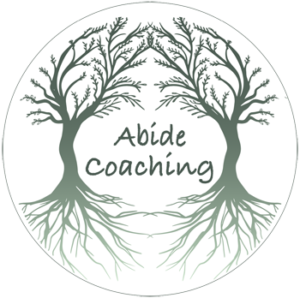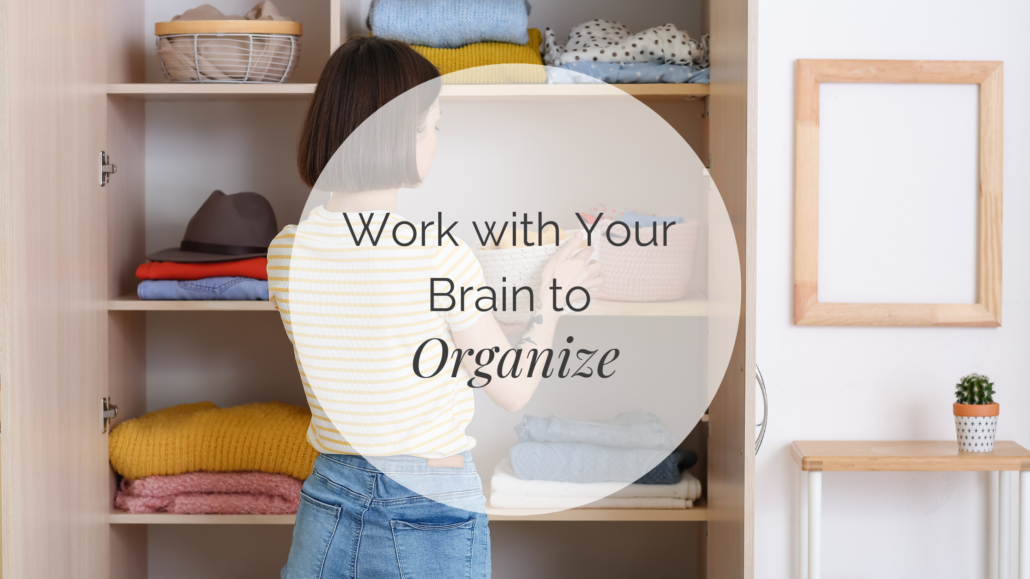This month I have teamed up with Karen Barela, professional organizer and senior move manager with GingerSugar, LLC.
Organizing and then maintaining that organization is not the neurodiverse brains’ favorite activity. Finding strategies that align with how your brain works, and making it fun, can help. But get rid of the ideas that:
- I should be able to
- Everyone else can
- If I try harder
Those thoughts only bring shame and guilt to tasks that don’t play well with your brain.
Here are some guidelines about organizing:
One of the tools to make your home feel less cluttered is keeping “like-items-together” and putting away items “where-they-belong.”
Keep “like-items-together” Ice cream and frozen foods – Where do they go? In the freezer, of course! You wouldn’t put items that belong in the freezer, say ice cream, in your clothes closet! Of course not; ice cream belongs in the freezer. There is no other choice.
Given this clear and simple example, why is the box of band-aids still on your living room coffee table? The band-aids package belongs with “like-other-items” such as where you keep your medical supplies. They may be in your bathroom medicine cabinet, but they might also be in a basket in your linen closet, a clear bin in your pantry, or a box in your laundry room. Here is where you need to set it up for your brain.
This strategy can work for other items that often end up where they don’t belong, like shoes, mail, batteries, water bottles, homework, toys, etc.
Sorting, grouping, and keeping “like-items-together” is an excellent method to help you move from feeling overwhelmed and stressed, to feeling calm, because you know where things are and can easily find them. You will save time because you can find your stuff quickly. It also enables you to see how much you have of a particular item, so you can stop buying what you already have, know when to stock up when you are low, or when you have too much of an item and need to downsize, donate or discard extras.
Quick Tip
Take a basket or cardboard box or plastic grocery bag and go from space to space, room to room, and grab things that don’t belong in that space. Dump everything onto a table or bed or clear out a space on the floor. Quickly sort “like items together.” All the pens and pencils, food and snack items, toys, pet toys, mail, magazines and books, remote controls, shoes, and band-aid boxes, and then return them item by item(s), one-by-one, to where they belong. Thinking again about the ice cream example, you wouldn’t leave the ice cream container out for days on the coffee table, on the floor in the den, or in the laundry room. So too, all these other items you picked up shouldn’t stay where they don’t belong.
Let’s consider another easy example. Pens and pencils (erasers, magic markers, rubber bands, paper clips, etc.) Lots of people keep these in the “junk drawer.” I (Karen) don’t believe in junk drawers, but that’s a topic for another post. I (Sheila) don’t believe in them either – most NDs are pretty particular about language, so the word junk isn’t serving you. If we were coaching, I would ask you what the purpose of that drawer is. In my house, the objective is to store office supplies. Find a name that follows the purpose. Do you have a plastic bin, an old jelly jar, or a drawer full of pens and pencils? Hopefully, you have just one designated spot! If you have more than one location throughout the house, it is much harder to return these items to their place with like- items-together. Once you have all the pens and pencils in one spot, you can stop there or go further and sort in detail. All #2 pencils, all mechanical pencils. All blue pens, all black pens, all red pens, and use a silverware drawer divider (for example) to keep pens and pencils extra sorted.
And in case you were wondering, vague, general, or weak decisions won’t do you any good. You have to be explicitly specific regarding what and how you organize. The more specific you can be, the easier it will be for you to organize any items. That’s why I like using ice cream as an example.
Why? Because it is so very made clear. Thinking about ice cream and pens are such good examples of opposite extremes of how to organize your home and keep things un-distracting and calm.
Here are some ideas for inspiration:
- Playrooms: group balls, cars, blocks, stuffed animals, legos, and puzzles. Things that don’t belong are shoes, mail, ice cream (!), or laundry detergent.
- Pen drawer: group pens, pencils, and erasers. Things that don’t belong are scissors, screwdrivers, rubber bands, or stamps.
- Medicine cabinet: group bandaids, cough drops, medications, and ointments. Things that don’t belong are cleaning supplies, contact lenses, or hair gel.
- Fridge/freezer: group fruits, vegetables, lunch items, and condiments.
- Pantry: beans, pasta, soup, and cereal. Things that don’t belong are toys, stamps, hammers, or mail.
These examples show how much easier it is to find what you’re looking for and know how much you have of something when they are grouped with other similar items.
Do you usually group similar items with each other? Which area(s) of your house lends itself best to this step in organizing?
Now that you are thinking “like-with-like,” let’s talk about strategies. NDs often need more than one tool in their toolbox to keep things from getting boring. Feel free to borrow one of these strategies that my (Shelia) clients have come up with to help organize and maintain:
- Talk to a coach about how you want your home to feel and how that can help you be a better you.
- Talk to a coach about your boundaries for keeping and discarding items.
- Organize in chunks – there are too many decisions to make to do a whole apartment or house.
- Make it a game
- Race a family member
- Beat the clock/set a timer
- Beat the clock but use a song you find motivating instead of a timer.
- Use timers
- Have a reward – often, some social outing is motivating.
- Play music and dance when putting things back where they go.
- Use the tip above daily or weekly.
- Use a body double – this could be someone you live with, but it could also be a virtual call.
- Tell someone what you want to do and ask them to check in with you in 5 minutes, 15 minutes, etc.
- Use music to help you focus.
- Invite people over for dinner; the looming deadline of people in your home will make most people declutter.
- Have a standing game night at your house – those horizontal surfaces will be needed for board games and will need to be cleaned off.
- Talk to yourself about
- What you are doing and how future you will thank you
- What you are doing and how it supports your short or long-term goals
- Use task switching – this is when you purposely switch tasks to get things done. This is not multitasking. Rather, you can keep things interesting within short spurts of time:
- Using a laundry washer or dryer cycle as a timer, do a task like homework or answering emails, and do 10-15 minutes of decluttering when the buzzer goes off.
- Use a Podomoro timer, and use the break to declutter.
- Use an Instagram page to take pictures of your space for more public accountability.
- Habit stacking
An organizational system is easiest to maintain by grouping similar items into the same areas, enabling you to find what you need quickly and keeping cleanup a simple process. This rule applies to organizing everyday items, including kitchenware, tools, toys, linens, and more. But remember, for the ND brain, keep it fun and interesting. Once it becomes “a should” or “a must,” it is hard to find that motivation again. Work with your brain, not against it.

